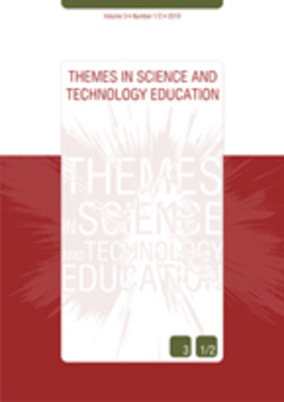Tracking the stages of learning : Concept maps as representations of liminal space
Part of : Themes in science and technology education ; Vol.5, No.1-2, 2012, pages 81-96
Issue:
Pages:
81-96
Author:
Abstract:
The concept of liminal space has recently been applied to ways of learning: the learning journey through this space encounters difficulties and misunderstandings, that are resolved as knowledge is mastered. Since 1992 the MirandaNet Fellowship, a growing international community of educators, has investigated the ways in which this relates to the collaborative learning in the liminal space of the Internet. These professionals have explored social networking, microblogging, digital mind mapping, distributed video and other innovative technologies to determine how they can be deployed through grassroots collaboration to build the theory and practice of new professional knowledge. The use of collaborative digital mind maps affords tools for the analysis of the stages and development of collaborative learning. From these shared liminal spaces beyond the screen provocative questions emerge about the relationship between learning, collaboration and innovation.
Subject:
Subject (LC):
Keywords:
Liminality, representation, mapping, collaboration, community, professional learning
References (1):
- Becta (2008). Harnessing Technology Review 2008: The role of technology and its impact on education. Coventry: Becta. Buzan, T. (2002). How to Mind Map: The ultimate thinking tool that will change your life. London: Thorsons.Cuthell, J. P. (2008). The role of a Web-based community in teacher professional development. International Journal of Web Based Communities, 2(8), 115–139.Cuthell, J. P. (2009a). Thinking and changing practice: Collaborative online professional development. In R. Carlsen, K., McFerrin R., Weber, & D. A.Willis (eds.), Proceedings of SITE 2000 (pp. 2264-2269). Norfolk, VA: Association for the Advancement of Computing in Education.Cuthell, J. P. (2009b). Thinking things through collaborative online professional development. In J. O. Lindberg & A. D. Olofsson (eds.), Online Learning Communities and Teacher Professional Development: Methods for ImprovedEducation Delivery (pp. 154-167). Hershey: IGI Global.Cuthell, J. P. (2012). Learning in Liminality. Retrieved 12 November 2012, fromhttp://www.virtuallearning.org.uk/?p=586Cuthell, J. P., Cych, L., & Preston, C. (2011). Learning in Liminal Spaces. Paper presented at Mobile Learning: Crossing boundaries in convergent environments Conference, University of Bremen. Retrieved October 20 2012, from http://www.virtuallearning.org.uk/wp-content/uploads/2011/03/Liminal-Spaces-Bremen.pdfCuthell, J. P., & Preston, C. (2009). The Use of Concept Maps for Collaborative Knowledge Construction. Retrieved 20 October 2012, from http://www.mirandanet.ac.uk/mirandamods/archive/the-use-of-concept-maps-for- collaborative-knowledge-construction.Cuthell, J. P., Preston, C., Cych, L., & Keuchel, T. (2009). iGatherings: from professional theory and practice to praxis in work based teaching and learning. WLE Centre, Institute of Education, University of London.Denning, T, Fisher, T & Higgins, C, (2011). From cradle to brave new world: the first 20 years of developing a research field in new technologies and teacher education, as reflected in the pages of JITTE/TPE. Technology, Pedagogy and Education. 20(3), 263-288Freire, P. (1970). Pedagogy of the Oppressed. London: Continuum International Publishing Group.Haythornthwaite, C. (2007). New international theories and models of and for online learning. First Monday. Volume 12, Retrieved 29 July 2009, from http://firstmonday.org/article/view/1976/1851.Jung, C. G. (1978). Man and His Symbols. London: Picador.Lave, J., & Wenger, E. (1991). Situated learning: Legitimate peripheral participation. Cambridge, UK: Cambridge University Press.Levi-Strauss, C. (1962). The Savage Mind. Oxford: Oxford University Press.MirandaNet (2012). http://www.mirandanet.ac.uk.MindMeister (2012). Should teachers blog?. Retrieved 20 October 2012, from http://www.mindmeister.com/23248899. Novak, J., & Cañas, A. (2006). The theory underlying concept maps and how to construct them. Florida: Institute for Human and Machine Cognition.O'Reilly (2005). What is Web 2.0. O'Reilly Media Inc. Retrieved 20 October 2012, from http://oreilly.com/web2/archive/what-is-web-20.html.Preston, C. (2008). Braided learning: an emerging practice observed in e-communities of practice. International Journal of Web Based Communities, 4(2), 220-243.Preston, C. (2009). Exploring semiotic approaches to analysing multidimensional concept maps using methods that value collaboration. In P. Torres & R. Marriott (eds.), Handbook of Research on Collaborative Learning Using Concept Mapping (pp. 256-282). Hershey: IGI Global.Preston, C. (2011). Gaining insight into educators’ understanding of digital technologies: Three models for the analysis of multi-dimensional concept maps. Doctorate in International Education, Institute of Education, University ofLondon.Preston, C., & Cuthell, J. (2011). MirandaMods: from practice to praxis in informal professional learning contexts. In A. Jimoyiannis (ed.), Research on e-Learning and ICT in Education (pp. 17-28). New York: Springer.van Gennep, A. (1960). The Rites of Passage. Chicago: University of Chicago Press.




